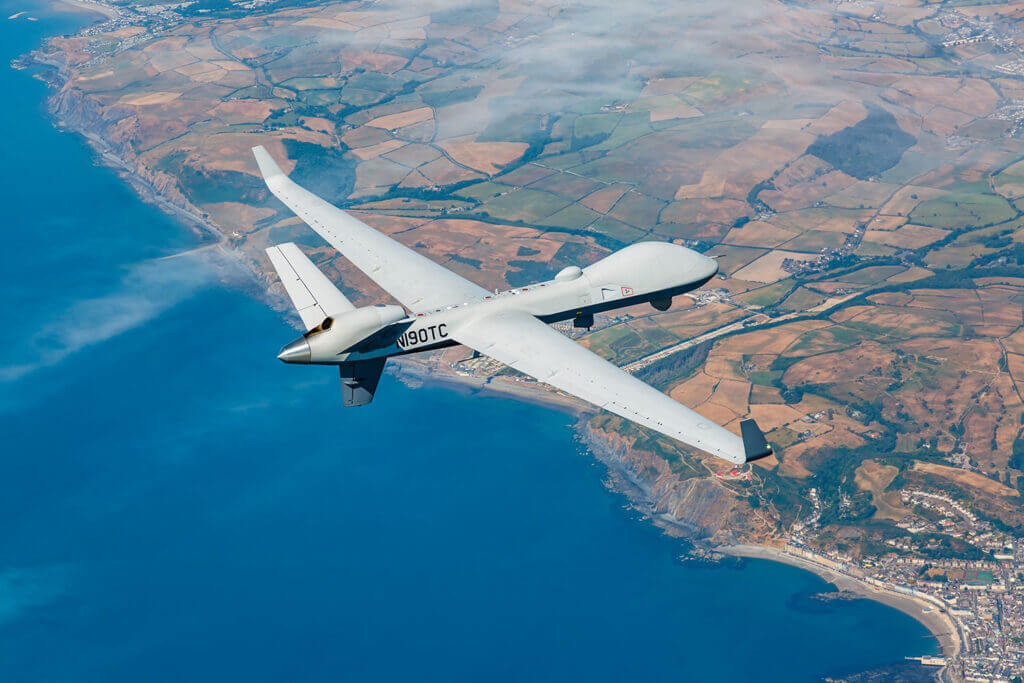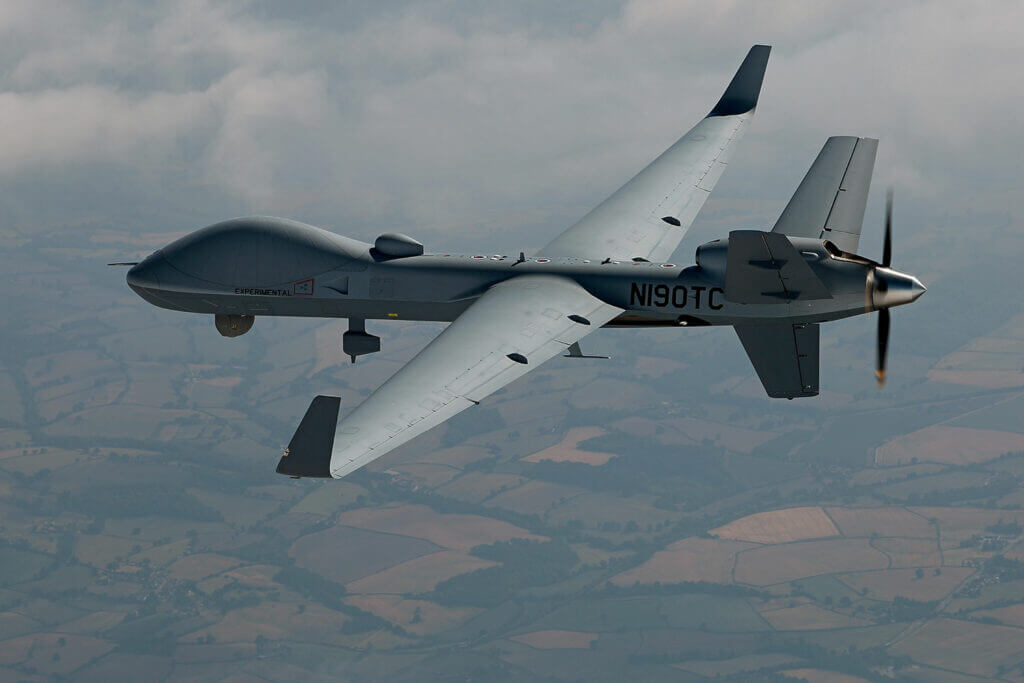Estimated reading time 7 minutes, 9 seconds.

More than five years after it began a “competitive procurement process,” the Canadian government has confirmed plans to spend $2.5 billion on 11 remotely piloted aircraft systems (RPAS) and associated training and infrastructure.
Announced Dec. 19, the contract with San Diego-based General Atomics Aeronautical Systems for its MQ-9B SkyGuardian — single-engine pusher turboprop roughly the size of a conventional fighter — was announced at the Royal Canadian Air Force (RCAF) bases where the drones are to be stationed: 19 Wing Comox, B.C., on the east coast of Vancouver Island, and 14 Wing Greenwood, N.S.
The procurement will be completed through a direct commercial sale contract with General Atomics and some components will be acquired through a foreign military sale (FMS) approved by the U.S. State Department.
Apart from the drones, training, two new hangars and ongoing sustainment services, the RPAS project includes a new ground control centre with 160 personnel in Ottawa, likely at the Department of National Defence (DND) secure campus in the capitol’s west end.
Aircrews will work from six ground control stations as well as a forward operating base when supporting Canadian Armed Forces missions in the North. Comox is expected to have 25 additional personnel, and Greenwood 55.
The personnel, aircraft and support infrastructure are expected to be fully operational by 2033 after initial aircraft delivery in 2028.
The government’s original plan was to have the drones operational by 2025, but the need for high-latitude missions in extreme conditions, which would involve other fixed-wing aircraft and satellites, required integration of new components on the MQ-9Bs, including the WESCAM MX-20 electro-optical/infrared sensor.
While Canada’s MQ-9Bs, with a mission radius of up to 1,850 kilometres and capable of staying aloft for as long as 34 hours, will not need to carry weapons in domestic airspace, they can be armed with an array of munitions for specific missions.
In mid-September, the State Department approved a $417.92 million (US$313.4 million) FMS for, among other things, 219 Hellfire II precision-strike missiles and 12 Mk82 500-lbs general purpose bombs. Eight wing hardpoints and one on its centreline give the SkyGuardian a maximum external payload capacity of nearly 2.16 tonnes.
“In deployed operations, an RPAS will provide commanders an overview of operational situations with near real-time information,” the government said in a statement. “The system will be capable of detecting, recognizing, identifying, tracking, and engaging targets in complex environments … There is no risk to aircrew life if a remotely piloted aircraft is lost or damaged because of an incident or enemy attack.”

While the investment marks “yet another significant milestone” for the RCAF as it approaches its centennial next year, and usually would be announced by the Defence Minister, Bill Blair had just returned to Ottawa on Dec. 19 from a four-day visit to NATO allies Latvia and Poland.
To maximize the political exposure, the announcement in Comox fell to Blair’s parliamentary secretary, Ottawa MP Marie-France Lalonde, who had been in Esquimalt the previous day to greet three Canadian navy ships returning from a four-month Indo-Pacific deployment. Nova Scotia MP Kody Blois, whose riding borders on the Greenwood area, did the honours there.
In addition to general surveillance and SAR work in two of the largest coastal and offshore coverage regions in the world, the new platforms are expected to support civilian operations such as wildfire and flood responses.
“The system will be capable of detecting, recognizing, identifying, tracking, and engaging targets in complex environments,” DND said in a statement. “It will also enable Canada to optimally fulfil its . . . NORAD and NATO missions while increasing interoperability with U.S. and NATO forces.”
An aide to Blair had told Skies that the project is expected to generate “hundreds of jobs across the country and millions in gross domestic product.” DND expanded on that, explaining in a statement that the project has the potential to create nearly 700 jobs annually for Canadian industry while contributing $97 million annually to GDP until the RPAS program becomes operational.
That means General Atomics is expected to provide “meaningful business activities and targeted investments to Canadian industry to support the growth of the overall aerospace and defence sector.”
To that end, the company has partnered with, among others, MDA, CAE and L3Harris Wescam under the banner Team SkyGuardian Canada.
“Canada’s vast territory and complex terrains, including in the Arctic, require a cost-effective multi-mission RPAS solution that can endure long periods on station, fly in harsh weather environments, and safely operate in all airspaces,” said Linden Blue, chief executive officer of General Atomics Aeronautical Systems. “MQ-9B SkyGuardian delivers those critical capabilities.”









While it’s nice to see Canada finally embrace armed UAS, as far as near-peer conflicts go this aircraft is old tech that is already on the verge of obsolescence NOW, much less 10 years from now when FOC is expected. How many of our allies will still be operating it by then? The USAF’s MQ-Next program aims to have the MQ-9 replacement operational by 2031. As far as combat capabilities go, it feels like we are buying weapons for the last war when Afghanistan and counterinsurgency-style conflicts were the major concern.
On the other hand this will be a positive addition to domestic missions and can help share many of CP-140’s current duties without having to incur the cost of firing up one of the new P-8s. In fact I suspect the P-8 and its operating costs may have been a key motivating factor for this purchase.
Further to BeaverFever’s comment, the costs associated with this Reaper buy are eye-watering, but the reference to 11 systems presumably means 44 air vehicles, i.e. four per system. Using the Reaper’s unit cost from the 2019 SAR (the last to reference the MQ-9), and escalating for 2023 dollars, that would then give a platform cost of (44 x US$23.5M x 1.2 x 1.33 =) C$1.6 Bn, meaning that training and infrastructure accounts for ~C$0.9 Bn.
Hi Ken,
A very nice and informative article to read about drones. Hope things are well with you on the West coast. Keep your badminton skills up.
If they are intended for all weather operations in the arctic, I would assume they have onboard de-icing capabilities with heated wings and props. It’s a sensible purchase given the limited number of aircraft purchases.
Actually the ground control center is going into the former Uplands base by Ottawa Airport. Along with AETE coming there as well around 260 RCAF Military Personal are coming back into the former base. It is good to see the military investing in a place that should not have been closed in the 1990’s. In addition more military housing is coming to Uplands as well
Again the site at Ottawa is going into the Uplands site. Since my last comment was not approved you can simply do a websearch and type in RPAS Uplands and you will find the info about a office building being built at the former base. It is good news as CFB Uplands should never have been closed in the first place leaving Trenton as the one overcrowded transport base in Canada. I am also assuming that this comment will not make the grade so do not publish it in any case